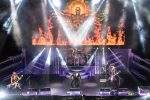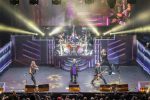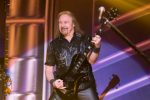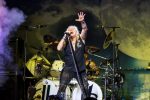REVIEW: Judas Priest delivers career-spanning mass in San Francisco

Judas Priest performs at The Warfield in San Francisco on June 24, 2019. Photos: Sean Liming.
SAN FRANCISCO — Judas Priest played the first night of its two-night stint at The Warfield on Monday. The legendary heavy metal act, formed almost 50 years ago in England, delivered a pulverizing set that featured songs from a variety of its 18 studio albums.
Judas Priest
Uriah Heep
8 p.m., Tuesday
The Warfield
Tickets: $70-$125.
Vocalist Rob Halford emerged onstage dressed in an elaborate purple suit and top hat and resembled a master of ceremony at a renaissance faire’s falconry exhibit. Flanked by his leather clad guitarists, Halford led the quintet through a blistering rendition of “Firepower,” the title track from the band’s most recent album, released last year.
While the setlist culled tracks from each era of Judas Priest’s history, the band seemed focused on doing what it does best: lots of galloping guitars with muted power chords and shredding, face-melting guitar solos—all punctuated by Halford’s iconic scream, which retained its characteristic similarity to both a lunch whistle and a young boy receiving a wedgie.
The precision twin-guitar assault at the heart of Judas Priest’s sound, originally developed by Glenn Tipton and K.K. Downing, was perfectly recreated by Richie Faulkner and Andy Sneap, who joined the band in the last decade after Tipton and Dowling departed. Faulkner, dressed in a shiny blouse with a plunging neckline, augmented every song with pyrotechnic guitar work. Sneap, clad in leather from head to toe and looking a little like a bad guy from the Fast and the Furious movies, provided the song’s chugging skeletal shape.
After playing the title track from its latest album, the band played some of its earliest material: “Heading Out to the Highway” from 1981’s Point of Entry and “The Sentinel” from 1984’s Defenders of the Faith. Both songs featured Judas Priest’s signature harmonized guitar leads and thundering riffs.
Halford left the stage every few songs only to reappear in a different jacket. The purple jacket gave way to a sleeveless leather trench coat, which was supplanted by a long iridescent jacket with silver fringe, and then another leather coat with “Heavy Metal” written on the back.
One of Faulkner’s most frenetic solos punctuated the grinding power chords of “Spectre,” off the band’s last album. On “Judas Rising” Faulkner took center stage to deliver another blistering solo while Halford gestured like a wizard conjuring a whirlwind of sound from Faulkner’s guitar.
Visuals of crucifixes drifting in space played on a screen behind the band during “Out in the Cold,” from 1986’s Turbo, while closeups of sword blades and dizzying oceans of red appeared on the screen during “Halls of Valhalla,” from 2014’s Redeemer of Souls.
Three quarters of the way through the set, Halford sat on a platform in front of the audience and spoke for the first time to a crowd of largely of graying fans dressed in various combinations of denim and leather: “We’ve got the heavy metal community in the house tonight.” The crowd responded with a barking chant of “Priest! Priest! Priest!” and a sea of devil’s horns being raised triumphantly.
After the career-spanning set, Judas Priest returned to play its three biggest hits in rapid succession. Halford emerged onstage again atop a large motorcycle as engine sounds filled the cavernous auditorium. The audience responded enthusiastically to the instantly recognizable opener to “Hell Bent for Leather,” from the band’s 1979 album, Killing Machine.
The crowd joined Halford to sing the chorus on the anthemic ode to transgression, “Breaking the Law,” from the band’s breakthrough album, 1980’s British Steel. Halford appeared for the evening’s final song in yet another jacket, this time a full-length, sleeveless denim robe bedazzled with patches and chains. As he led the band through its final song, “Living After Midnight,” his voice, full of its old operatic menace, sounded as sharp and pointed as the guitars onstage.
Between Judas Priest and the opening act Uriah Heep, the audience was able to witness a combined century’s worth of British heavy metal.
Uriah Heep began the evening with a song called “Take Away My Soul,” from its new album, Living the Dream. Founding guitarist and the only remaining original member, Mick Box, delivered a wah-inflected guitar solo while vocalist Bernie Shaw strutted around the stage in tights, a sleeveless denim shirt, and shiny, pointy shoes, his bleached blonde hair hanging in his face.
The quintet mined its five-decade career. “Sunrise,” from 1972 album The Magician’s Birthday, began with lush synthesizer sounds over a simple kick drum. The band introduced “Gypsy” from 1970’s Very ‘Eavy Very ‘Umble, by telling the audience it had played the song in 61 countries.
Many of the songs in the set provided jumping off points for extended jams, such as “Stealin,'” from 1973’s Sweet Freedom, and “Easy Livin,'” off 1972’s Demons and Wizards. Box would trade musical ideas with bassist Davey Rimmer or keyboardist Phil Lanzon. These improvisational excursions were often enhanced by columns of smoke that blasted from the front of the stage. The chaotic musical soundscape was anchored by the simultaneously smooth and frenetic drumming of Russell Gilbrook.
Judas Priest and Uriah Heep helped give birth to the new wave of British heavy metal—or NWOBHM, as it’s more commonly known. Thirty years ago, bands like Metallica tapped into this new wave’s raw energy and gave birth to thrash, but even bands as different as Dream Theater and Venom have found inspiration in these bands’ creative combining of raw energy and virtuosic musicality.
- Judas Priest performs at The Warfield in San Francisco on June 24, 2019.
- Judas Priest performs at The Warfield in San Francisco on June 24, 2019.
- Judas Priest performs at The Warfield in San Francisco on June 24, 2019.
- Judas Priest performs at The Warfield in San Francisco on June 24, 2019.
- Judas Priest performs at The Warfield in San Francisco on June 24, 2019.
- Judas Priest performs at The Warfield in San Francisco on June 24, 2019.
- Judas Priest performs at The Warfield in San Francisco on June 24, 2019.
- Judas Priest performs at The Warfield in San Francisco on June 24, 2019.
- Judas Priest performs at The Warfield in San Francisco on June 24, 2019.
- Judas Priest performs at The Warfield in San Francisco on June 24, 2019.
- Judas Priest performs at The Warfield in San Francisco on June 24, 2019.
- Judas Priest performs at The Warfield in San Francisco on June 24, 2019.
- Judas Priest performs at The Warfield in San Francisco on June 24, 2019.
- Judas Priest performs at The Warfield in San Francisco on June 24, 2019.
- Judas Priest performs at The Warfield in San Francisco on June 24, 2019.
- Judas Priest performs at The Warfield in San Francisco on June 24, 2019.
- Judas Priest performs at The Warfield in San Francisco on June 24, 2019.
- Judas Priest performs at The Warfield in San Francisco on June 24, 2019.
- Judas Priest performs at The Warfield in San Francisco on June 24, 2019.
- Uriah Heep performs at The Warfield in San Francisco on June 24, 2019.
- Uriah Heep performs at The Warfield in San Francisco on June 24, 2019.
- Uriah Heep performs at The Warfield in San Francisco on June 24, 2019.
- Uriah Heep performs at The Warfield in San Francisco on June 24, 2019.
- Uriah Heep performs at The Warfield in San Francisco on June 24, 2019.
- Uriah Heep performs at The Warfield in San Francisco on June 24, 2019.
- Uriah Heep performs at The Warfield in San Francisco on June 24, 2019.
Follow writer David Gill at Twitter.com/DavidGi18788752. Follow photographer Sean Liming at Twitter.com/SeanLiming and Instagram.com/S.Liming.





























